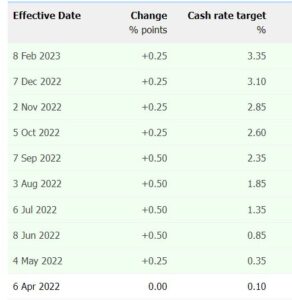It’s Feb 16th 2023 and there seems to an inordinate amount of negative news, daily around Inflation, the cost of living in Australia, rising interest rates and more to come and yet the Unemployment rate is still very low in a historical context.
Big Wave Digital works in finding and placing top talent in Digital Marketing, Blockchain and Technology in companies small and large across Australia, so what are we seeing and what is the link between Inflation rate/s and the unemployment levels in Australia?
Here goes…
Inflation and unemployment are two of the most important economic indicators, and they are closely related to each other.
In general, inflation refers to the rate at which the general price level of goods and services increases over time.
Unemployment, on the other hand, refers to the percentage of the labour force that is unemployed but actively seeking employment. The relationship between inflation and unemployment is known as the Phillips Curve, which shows an inverse relationship between the two.
In the case of the Australian economy in 2023, if inflation continues to rise, it is likely that the Reserve Bank of Australia (RBA) will raise interest rates in order to curb inflation. This could have an impact on the unemployment rate in Australia.
And raise rates they are, from a low of .1% in April 2022 it’;s already at 3.35

When the RBA raises interest rates, it becomes more expensive for businesses to borrow money, and they may be less likely to invest in new projects or expand their operations. This could lead to a slowdown in economic activity, which could result in higher unemployment levels.
It is worth noting that the impact of rising interest rates on the unemployment rate is not immediate. It can take some time for businesses to adjust to the new economic conditions, and for the full impact of interest rate changes to be felt in the labour market.
It is also possible that the Australian economy could experience a temporary period of stagflation, where there is both high inflation and high unemployment. This could happen if the increase in interest rates leads to a significant decrease in economic activity, which could result in both rising prices and higher levels of unemployment.
Stagflation is bad, very bad, in the short term, if inflation continues to rise and interest rates are raised, it is possible that the unemployment rate in Australia could increase. However, in the longer term, if the RBA is successful in controlling inflation, the Australian economy could return to a more stable growth path, which could ultimately lead to lower unemployment levels.
in the short term, if inflation continues to rise and interest rates are raised, it is possible that the unemployment rate in Australia could increase. However, in the longer term, if the RBA is successful in controlling inflation, the Australian economy could return to a more stable growth path, which could ultimately lead to lower unemployment levels.
It is also worth noting that the relationship between inflation and unemployment is complex, and there are many other factors that can influence the unemployment rate in addition to changes in interest rates and inflation. Factors such as changes in Australian government policy, international trade ie Macro global conditions, and technological change can also have a significant impact on the labour market.
Is AI a threat or will it help us get new jobs ?

In addition to the impact of inflation and interest rates on the unemployment rate, there are a few other factors to consider when analyzing the Australian economy and labour market.
The ongoing COVID-19 pandemic, which has had a significant impact on the Australian economy over the past two years. While Australia has generally been successful in controlling the spread of the virus, there have been periodic lock-downs and restrictions on economic activity that have had an impact on businesses and the labor market. These disruptions have had a particularly large impact on industries such as hospitality, tourism, and retail, which have seen significant job losses.
Another issue to consider is the ongoing shift towards a more service-based economy in Australia.
Over the past few decades, there has been a trend towards the growth of service-based industries such as healthcare, education, and professional services. This shift has resulted in a decline in the relative importance of traditional industries such as manufacturing and mining. While this trend has created new opportunities for employment, it has also resulted in changes to the nature of work, with an increasing emphasis on part-time and casual employment.
The ongoing challenge of addressing structural unemployment in Australia. Structural unemployment refers to long-term unemployment that results from a mismatch between the skills and experience of workers and the available job opportunities. In Australia, there are significant disparities in employment outcomes between different demographic groups, with Indigenous Australians, people with disabilities, and people from low-income backgrounds experiencing higher rates of unemployment.
Of course the Australian economy and labour market are closely linked to the global economy. Changes in global economic conditions, such as changes in commodity prices, trade policies, and geopolitical tensions, can have a significant impact on the Australian economy and the labour market.
As you can see the Australian economy and labour market are complex systems with many interrelated factors that can influence the unemployment rate. While inflation and interest rates are important factors to consider, it is also important to take a holistic view of the economy and to consider the many other factors that can influence the labor market in Australia.
Thanks for reading,
Cheers Keiran
Let us help you build a Brilliant team in Digital, Blockchain, and Technology.
Big Wave Digital are experts in Digital Recruitment Sydney
At Big Wave Digital , Sydney’s leading digital, blockchain and technical recruitment agency, we have deep connections, experience and proven expertise, and the ability to achieve a win for all parties in the challenging recruiting process. We can connect to highly coveted digital and tech talent with the world’s best employers. To discover more, just give us a call at (02) 9380 4431.
Keiran Hathorn is the CEO & Founder of Big Wave Digital. A Sydney based niche Digital, Blockchain & Technology recruitment company. Keiran leads a high performance, experienced recruitment team, assisting companies of all sizes secure the best talent.

